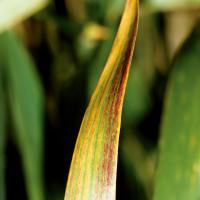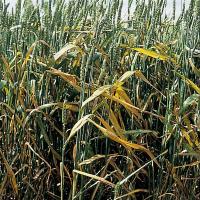Diagnosing yellow dwarf virus
A cereal disease caused by two similar viruses (barley yellow dwarf virus and cereal yellow dwarf virus). These diseases are spread by several colonising aphid species. Infection before tillering can cause large yield losses.
What to look for
- 'Hot spots' or small patches of yellow or red stunted plants.
- Symptoms are less obvious in winter becoming more predominant in warm weather.
- Late infection (spring) may cause only slight yield loss.
Paddock
- In wheat, leaf yellowing with interveinal chlorosis.
- Reddening of flag leaf.
- In oats, reddening (red/orange/brown) of leaves from tip down.
- Leaves turn yellow from the tips and may have yellow stripes extending towards the base.
- Flag leaf smaller and more erect.
- Younger leaves sometimes distorted (this may also be due to aphid feeding damage).
- Early-infected plants become stunted with poorly developed tillers.
- Edges of mature leaves may become red or purple.
- Abortion of terminal spikelets.
- Shrivelled grain.
Plant
What else could it be
| Condition | Similarities | Differences |
|---|---|---|
| Diagnosing wheat streak mosaic virus | Plant symptoms | Differences include WSMV having less vivid stripes. WSMV affect younger leaves causing broken stripes that join as the leaf ages |
| Diagnosing zinc deficiency in wheat | Stunted plants with many tillers and striped leaf lesions | However zinc deficient plants have pale linear spots or lesions that can develop into parallel 'tramlines' and they lack vivid yellow streaks towards the leaf tip |
| Diagnosing zinc deficiency in oats | Red/yellow leaf colours and necrosis that starts at the tip | Necrotic areas often contain red-brown lesions. The disorder is associated with soil type rather than being circular or near the edge of the paddock. |
Where did it come from?

Insect vector
- Migrating aphids spread YDV's into crops to form small patches of affected plants that gradually enlarge and are focal points for further spread.
- YDV and aphids survive between growing seasons in perennial grasses. Substantial rainfall during February-April stimulates grass growth that favours aphid buildup before they move into emerging crops.
- Early infection is more likely in high rainfall areas where there are more over-summering grasses and early sown cereals.
- In the wheatbelt, infection is more common in spring as aphids move inland.
Management strategies

Seed treatment

Resistant varieties
- In high risk areas applying a seed treatment or preventative insecticide (2-4 weeks after sowing) to control aphids is most cost effective when potential yields are high.
- It is vital to prevent the spread of YDV during the first 8-10 weeks after crop emergence as this is when plants are most vulnerable to the virus.
- Sow tolerant varieties.
How can it be monitored?
- Aphid level is a poor indicator of infection, as low aphids numbers can transmit YDV.
See also
Where to go for expert help
Page last updated: Friday, 10 July 2015 - 3:22pm






